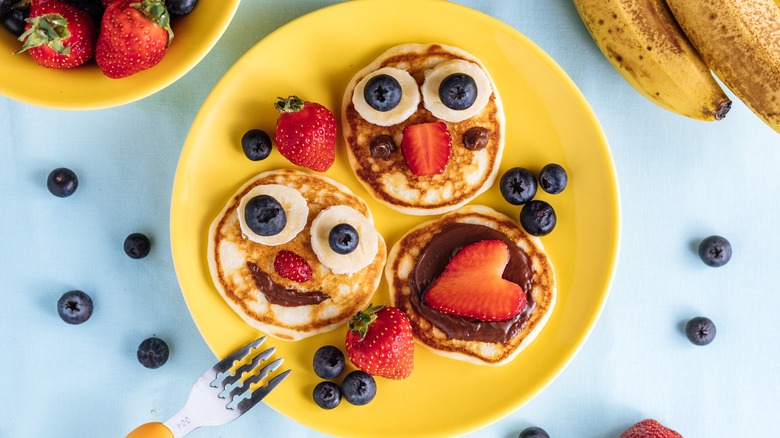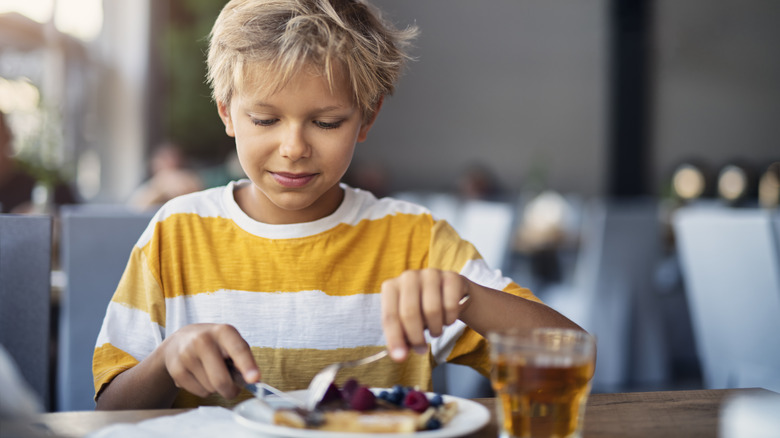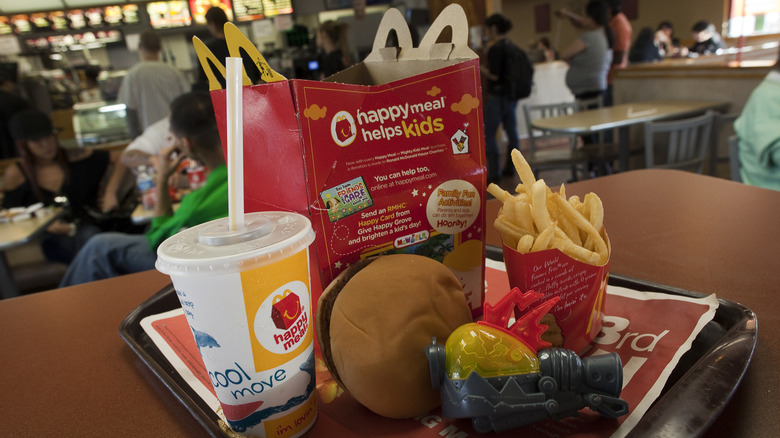The Prohibition Era Origins Of The Kids' Menu
Being a child at a restaurant is an experience like no other. You're handed a colorful menu full of puzzles, games, and a list of all your favorite foods. You get a special-sized cup, ideally with a bendy straw, a plate of buttered noodles, and enough crayons to color the night away while the grown-ups around you eat their fancy meals. At certain restaurants, it's even encouraged for kids to color right on the kraft paper at the table. Many restaurants — especially large casual dining chains — cater to young kids who enter their eateries, but that wasn't always the case.
Before the 1920s, American families rarely brought their children out to eat. Not only was it much more expensive than home cooking, but restaurants simply did not offer dishes that children normally enjoyed. However, when Prohibition restricted restaurants from selling alcohol to adults, their new strategy was to cater to the next generation of diners, as noted in a 2013 deep dive published by Slate.
Eateries lost a ton of profit when the United States went "dry" in 1920. This new law drastically altered the way that people saw eating out. No longer able to drink in public, many people searched for hidden speakeasies instead of restaurants. This meant the environment was more family-friendly than ever, and restaurants took advantage. This is when the concept of the "kids' menu" was born, encouraging families to bring their children out to eat.
Back in the day, children were eating lamb chops instead of chicken nuggets
The kids' menu has been around for nearly a century, but its early years had menu items that little ones today may turn their noses at. According to Slate, it is suspected that the high-end New York City restaurant, located at the infamous Waldorf Astoria, was one of the very first restaurants to offer a kids' menu. Unlike the chic menus that adults were given, these kids' menus were said to have illustrations of nursery rhymes.
Menu choices for kids included typical dishes like chicken and rice, steamed veggies, poached eggs, and lamb chops, per The New York Times. Many of the dishes geared towards children were blander alternatives to those offered to adults, most likely allowing the restaurant to keep the same ingredients and meal concepts while making a profit off their newest little patrons. It wasn't until the 1950s, when fast food took off in America, that kids' menus offered the items we now associate with young eats.
Contemporary kids' menus have evolved quite a bit since the Prohibition era, offering common items like chicken nuggets, grilled cheese, and spaghetti that cater to a milder flavor palate. Some fast food kids' menus are specifically geared toward nutrition, including certain fresh ingredients like apple slices and whole milk, along with small portion sizes that allow children to fuel up on necessary proteins and carbs meant for holistic physiological development.
Is the kids' menu strictly for ages 12 and under?
Nowadays, kids' menus are pretty much expected at most eateries, regardless of how many stars the restaurant might have. But not everyone who orders off the kids' menu is still a kid, which begs the question: should adults be allowed to order Happy Meals and menu items meant for little ones?
The Washington Post once posed this very question, and in turn received negative feedback from food critics who claimed that the practice is "tacky." In fact, the article made it clear that many restaurant executives and service workers detest when adults order from menus curated for children, even when there is no age restriction specifically printed. Kids' menu options are often significantly cheaper than the other dishes because of their smaller portions. However, the types of food that usually populate kids' menus are also much cheaper and easier to produce, meaning that restaurants can more easily profit.
Users in a Reddit thread also debated this topic, with one offering a much different viewpoint, "Restaurants need to offer smaller portion entrées that are priced appropriately. Sometimes I want to order something but it's way too much and I'm going somewhere after so leftovers don't make sense." Other users discussed various dietary restrictions, aversions, and allergies that leave few options for them other than what's listed on a kids' menu. Ultimately, nothing is stopping you from ordering off of most kids' menus, although you may get a few judgmental looks.


